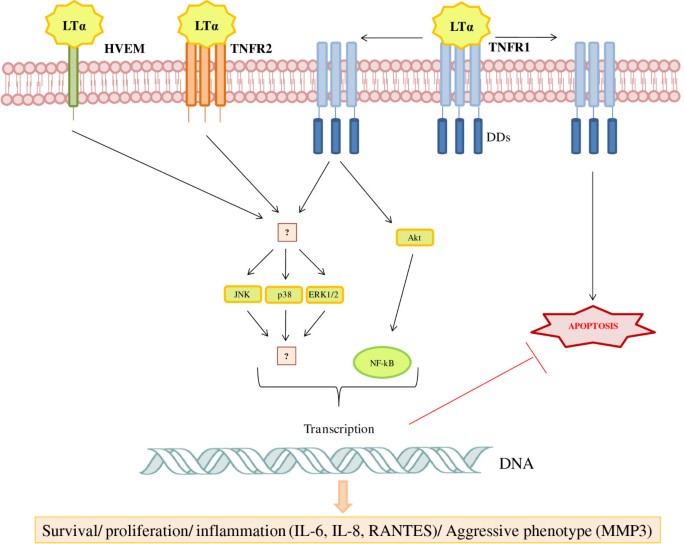What is LTA Protein
Lymphotoxin alpha (LTA), also known as tumor necrosis factor beta (TNF-β), stands as a pivotal member within the TNF superfamily. This multifaceted protein has garnered attention under various aliases, including TNF-C, TNFSF1, and LT-α. LTA exhibits structural elegance with a trimeric arrangement, showcasing its belonging to the TNF superfamily, renowned for its role in orchestrating immune responses and cellular survival. Recent advancements in research have delved deeper into the intricacies of LTA, unraveling its nuances in health and disease.
LTA Biological Functions and Molecular Mechanisms
LTA functions as a potent regulator of immune responses, wielding influence over a spectrum of biological activities. This includes immune cell proliferation, apoptosis, and inflammation. One of its key roles lies in the activation of NF-κB, a transcription factor orchestrating a myriad of genes involved in immune and inflammatory responses. Additionally, LTA has been implicated in the formation of secondary lymphoid structures, critical for effective immune surveillance.
Molecularly, LTA engages with its receptors, TNFR1 and TNFR2, initiating cascades that culminate in a complex network of signaling events. These intricate interactions underscore the significance of LTA in maintaining immune homeostasis and defending against microbial threats.

Figure 1. Proposed model for the action of lymphotoxin alpha (LTα) in rheumatoid arthritis (RA) fibroblast-like synoviocytes (FLSs). (Calmon-Hamaty F, et al., 2011)
LTA Related Signaling Pathway
The LTA signal pathway is a complex network that governs cellular responses to external stimuli. LTA primarily engages with its receptor, TNFR1, initiating downstream signaling cascades. This interaction triggers the activation of transcription factors, such as NF-κB, leading to the expression of genes involved in inflammation, immunity, and cell survival. A comprehensive understanding of the LTA signal pathway is crucial for unraveling its involvement in both health and disease.
LTA Related Diseases
While LTA plays a crucial role in immune regulation, dysregulation can tip the scales towards pathology. Aberrant LTA expression has been linked to autoimmune disorders such as rheumatoid arthritis and inflammatory bowel diseases. The intricate balance maintained by LTA is disrupted in these conditions, leading to persistent inflammation and tissue damage. Understanding the nuances of LTA's involvement in these diseases provides a foundation for targeted therapeutic interventions.
LTA's Applications in Biomedicine
LTA's significance extends beyond the confines of basic research, finding practical applications in the realm of biomedicine. Diagnostic development has benefited from the unique molecular fingerprints of LTA, with its presence or absence serving as a biomarker for certain diseases. Moreover, the protein's role in immune regulation has spurred interest in vaccine development, as researchers explore ways to harness its potential for immunomodulation.
In therapeutics, LTA holds promise as a target for novel drug development. Pharmaceutical research endeavors are focused on designing molecules that can modulate LTA's activity, offering new avenues for treating conditions where dysregulation of LTA is implicated. As our understanding of LTA deepens, so too do the prospects for innovative therapeutic interventions.
Recommended Products
| Cat.# | Product name | Species | Source (Host) | Tag |
|---|---|---|---|---|
| LTA-554H | Active Recombinant Human LTA protein | Human | E.coli | N/A |
| LTA-5068H | Recombinant Human Lymphotoxin Alpha (TNF superfamily, member 2), His-tagged | Human | Human | His |
| LTA-310H | Recombinant Human LTA protein | Human | E.coli | N/A |
| Lta-070H | Recombinant Human Lta Protein | Human | ||
| LTA-311H | Recombinant Human Lymphotoxin Alpha, His-tagged | Human | E.coli | His |
| LTA-568H | Recombinant Human LTA protein, His & T7-tagged | Human | E.coli | His/T7 |
| LTA-4599H | Active Recombinant Human LTA Protein, His/Flag/StrepII-tagged | Human | Human cells | His/Flag/StrepII |
| LTA-9342M | Recombinant Mouse LTA Protein | Mouse | Mammalian Cell | His |
| LTA-5234M | Recombinant Mouse LTA Protein, His (Fc)-Avi-tagged | Mouse | HEK293 | His (Fc)-Avi |
| Lta-3187M | Recombinant Mouse Lta protein, His&Myc-tagged | Mouse | E.coli | His&Myc |
Reference
- Calmon-Hamaty F, et al. Lymphotoxin α revisited: general features and implications in rheumatoid arthritis. Arthritis Research & Therapy. 2011, 13: 1-5.

